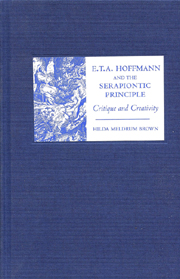Book contents
- Frontmatter
- Contents
- List of Illustrations
- Preface
- Acknowledgments
- List of Abbreviations
- Introduction: Approaches to the Serapiontic Principle
- Part 1
- Part 2
- 7 Frame Narrative and the Serapiontic Principle
- 8 From Visual to Verbal: Three Serapiontic Tales
- 9 The “Nachtseite der Natur” and the Serapiontic Principle
- 10 The Märchen and the Serapiontic Principle
- 11 The Serapiontic Principle: The Wider Critique
- Conclusion
- Select Bibliography
- Index
7 - Frame Narrative and the Serapiontic Principle
from Part 2
Published online by Cambridge University Press: 05 February 2013
- Frontmatter
- Contents
- List of Illustrations
- Preface
- Acknowledgments
- List of Abbreviations
- Introduction: Approaches to the Serapiontic Principle
- Part 1
- Part 2
- 7 Frame Narrative and the Serapiontic Principle
- 8 From Visual to Verbal: Three Serapiontic Tales
- 9 The “Nachtseite der Natur” and the Serapiontic Principle
- 10 The Märchen and the Serapiontic Principle
- 11 The Serapiontic Principle: The Wider Critique
- Conclusion
- Select Bibliography
- Index
Summary
The Frame
Hoffmann's development of the well-established German tradition of frame narrative takes the form to new heights, though this has scarcely been noted, so much has the attention of commentators been fixed on the individual tales in the collection. The starting point for Goethe's pioneering frame-narrative Unterhaltungen deutscher Ausgewanderten, had been recent history, that is, the forced expulsion of German communities resident on the left bank of the Rhine during the Revolutionary Wars with France. Likewise Hoffmann, now writing at a later phase in the Napoleonic saga, makes several allusions to the recent war and its conclusion (his character Cyprian had fought in the campaign and, like Hoffmann himself, had witnessed the bombardment of Dresden), but in these changed circumstances his political stance is distinctly upbeat by comparison. There are several important references to the final stages of the struggle (The Battle of the Nations) but also optimism about the new spirit of regeneration in a war-torn land that was now at peace again. Hoffmann's idea of creating a frame in which to situate his tales, most of which had previously been published in literary journals, dates from early 1818, and as we have already seen, the model of Tieck's Phantasus suggested itself first to Hoffmann himself and then to his publisher, Reimer (whose house had published volumes of the Tieck work between 1812 and 1816), once the search for a suitable “Einkleidung” for the collection of tales was on.
- Type
- Chapter
- Information
- E. T. A. Hoffmann and the Serapiontic PrincipleCritique and Creativity, pp. 119 - 134Publisher: Boydell & BrewerPrint publication year: 2006



